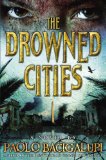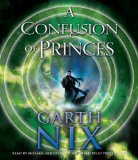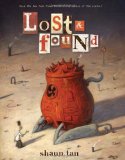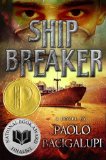Review of The Search for WondLa, by Tony DiTerlizzi
by Tony DiTerlizzi
with illustrations by the author
Simon & Schuster Books for Young Readers, 2010. 477 pages.
Starred Review
The Search for WondLa is an illustrated adventure tale written in the style of The Wizard of Oz. I had the wonderful opportunity to have dinner with the author at ALA Midwinter Meeting, and he said he wrote The Search for WondLa for his ten-year-old self. He succeeded beautifully.
The story, like The Wonderful Wizard of Oz, is about the search for Home. Also, like Oz, our heroine meets fantastical beings, both friends and fearsome enemies, along the way. She must journey across a strange and foreign landscape in quest of Home and someone like herself.
Eva Nine has been raised in an underground Sanctuary under the supervision of a kind robot called Muthr (Multi-Utility Task Help Robot). But Eva feels constrained, always protected. She has explored parts of the Sanctuary that she wasn’t supposed to know about. She found something that gives her hope:
When she’d discovered this item more than a year before, Eva had tried to identify it with her Omnipod, but the device had concluded that, “There is insufficient data. Not enough information to make an identification.” Eva had determined that it was likely a small piece of tile or even paneling, possibly a sign of sorts, as it was square shaped. On it was an image (a broken one, since it no longer moved) of a little girl holding hands with a robot and an adult.
The only item in Eva’s secret collection not given to her by Muthr.
The only item in her secret collection not identifiable by her Omnipod.
An item another human had left for her, here, by this sealed door.
Proof.
She couldn’t make out who exactly the adult in the image was. The scorched damage obscured the face in soot. However, she could see two letters on this worn piece of paneling: L and a. There was a second, smaller piece to this puzzle, which she had discovered as well. Eva had glued this missing fragment to the top of the panel. It, too, had fancy letters printed on it: “Wond.”
“WondLa,” Eva had dubbed it. She studied the picture in her hands. The girl was smiling. The robot was smiling. Eva was certain the adult was likely smiling too as they all walked together in unison through a field of flowers. Moving as one. As friends. Exploring the forests above.
But Eva’s robot would not allow her to explore. She wouldn’t even let her leave the Sanctuary.
When Eva’s Sanctuary is breached by a monstrous creature looking for new species, Eva is suddenly thrust out into the outside world. But nothing is as Eva expected it to be. The Omnipod can’t identify anything. And among all the creatures out there, there is none other like her.
As Eva tries to escape the horrible huntsman, she makes friends with other creatures in his clutches. But none of them are like her.
So Eva travels through a strange and wondrous world, looking for a place of safety, looking for Home.
The many detailed pictures make this an enthralling adventure tale all the more ready to lure in readers. And it’s only the first volume, so although this book stands alone well, readers can find out what happens to Eva Nine next.
Find this review on Sonderbooks at: www.sonderbooks.com/Childrens_Fiction/search_for_wondla.html
Disclosure: I am an Amazon Affiliate, and will earn a small percentage if you order a book on Amazon after clicking through from my site.
Source: This review is based on a library book from the Fairfax County Public Library.
Disclaimer: I am a professional librarian, but I write the posts for my website and blogs entirely on my own time. The views expressed are solely my own, and in no way represent the official views of my employer or of any committee or group of which I am part.
Please use the comments if you’ve read the book and want to discuss spoilers!









